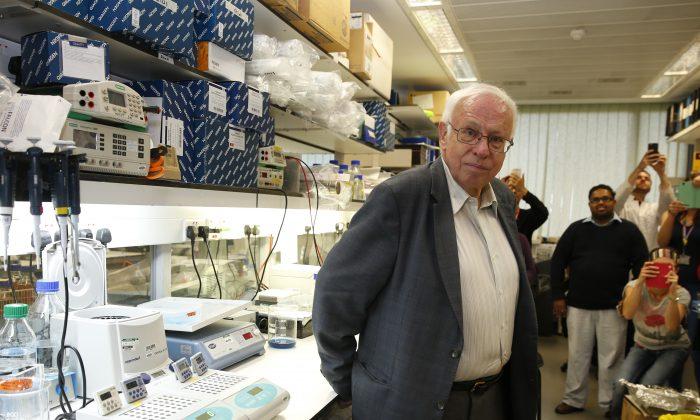STOCKHOLM— Three scientists from Sweden, the U.S. and Turkey won the Nobel Prize in chemistry on Wednesday for showing how cells repair damaged DNA — work that has inspired the development of new cancer treatments.
Swedish scientist Tomas Lindahl, American Paul Modrich and U.S.-Turkish scientist Aziz Sancar shared the 8 million Swedish kronor (about $960,000) award for research done in the 1970s and ‘80s.
The Royal Swedish Academy of Sciences said their work on DNA repair had provided “fundamental knowledge” about how cells function and shed light on the mechanisms behind both cancer and aging.
Lindahl, 77, is an emeritus group leader at the Francis Crick Institute and Emeritus director of Cancer Research UK at Clare Hall Laboratory in Britain.
Modrich, 69, is an investigator at Howard Hughes Medical Institute and professor at Duke University School of Medicine in Durham, North Carolina.
[aolvideo src=“http://pshared.5min.com/Scripts/PlayerSeed.js?sid=1759&width=580&height=350&playList=519136742&responsive=false&pgType=console&pgTypeId=editVideo-overviewTab-copyCodeBtn”]
Sancar, also 69, is a professor at the University of North Carolina School of Medicine in Chapel Hill, North Carolina. He is the second Turk to win a Nobel Prize, after novelist Orhan Pamuk was awarded the literature prize in 2006.
Sancar told The Associated Press the news was “quite a surprise” since he thought his best chance to win a Nobel was in the medicine category, which was announced Monday.
“It was a surprise in the sense that my work is at the interface of medicine and chemistry,” he said, adding that the win would be “very important” for Turkey.
“Young Turkish scientists need a role model showing that they can accomplish important contributions to science,” he said.
[morearticles]1776249[/morearticles]
Lindahl, who has worked for decades in Britain, said he was having breakfast when a “nice lady” from the academy called. It was only when she started speaking in Swedish that he realized it may not be a hoax.
“Then, of course, it starts sinking in that this is a great honor and a fantastic way of winding up my career,” he told reporters at his laboratory near London.
Modrich, on vacation in New Hampshire, said he found out about his prize via an email from a colleague.
[morearticles]1747944[/morearticles]
“Stockholm didn’t get my number, I guess, until later in the morning,” he told the AP.
But Nobel officials did reach him “eventually, so I think it’s real,” he said with a chuckle.
Working separately, the laureates broke new ground by mapping and explaining how a cell safeguards its DNA — the molecule that contains our genes. Our DNA is constantly under assault from ultraviolet rays from the sun and carcinogenic substances.
But it was thought to be a stable molecule until the 1970s, when Lindahl showed that it decays at a rate that seemed incompatible with human life. He realized that there must a repair mechanism, opening a new field of research, the academy said.
Working at Yale University, Sancar mapped the mechanism that cells use to repair UV-damaged DNA. Modrich showed how the cell corrects errors when DNA is replicated during cell division.
The findings are significant for cancer research, because cancer cells are kept alive by DNA repair mechanisms. Researchers are now looking at ways to destroy the repair mechanisms within the cancer cells to kill them, academy member Peter Brzezinski said.
The academy highlighted one such drug that’s already on the market: olaparib, which is used to fight ovarian cancer.
The award will be handed out along with the other Nobel Prizes on Dec. 10, the anniversary of prize founder Alfred Nobel’s death in 1896.
This year’s medicine prize went to three scientists from Japan, the U.S. and China who discovered drugs to fight malaria and other tropical diseases. Japanese and Canadian scientists won the physics prize for discovering that tiny particles called neutrinos have mass.
The Nobel announcements continue with literature on Thursday, the Nobel Peace Prize on Friday and the economics award on Monday.





